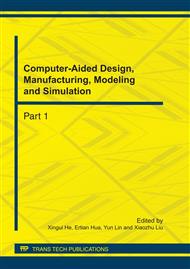[1]
A. Wheeler, Commercial Applications of Wireless Sensor Networks Using ZigBee, IEEE Communications Magazine, vol. 45, no. 4. 70-77 (2007).
DOI: 10.1109/mcom.2007.343615
Google Scholar
[2]
Carl K. Chang, Hsinyi Jiang, Hua Ming, Katsunori Oyama: Situ: A Situation-Theoretic Approach to Context-Aware Service Evolution. IEEE T. Services Computing 2(3): 261-275 (2009).
DOI: 10.1109/tsc.2009.21
Google Scholar
[3]
J. Hightower and G. Borriello, Location Systems for Ubiquitous Computing, IEEE Computer , vol. 34, no. 8. 57-66 (2001).
DOI: 10.1109/2.940014
Google Scholar
[4]
K. Pahlavan, X. Li, and J. P. Makela, Indoor Geolocation Science and Technology, IEEE Communications Magazine , vol. 40, no. 2. 112-118 (2002).
DOI: 10.1109/35.983917
Google Scholar
[5]
R. Want, A. Hopper, V. Falcao and J. Gibbons. The Active Badge Location System. ACM Transactions on Information System 10, 1, 91-102 (1992).
DOI: 10.1145/128756.128759
Google Scholar
[6]
A. Harter, A. Hopper, P. Steggles A. Ward and P. Webster. The Anatomy of a Context-Aware Application. In Proc. 5th ACM MOBICOM Conf. Seattle, WA. (1999).
DOI: 10.1145/313451.313476
Google Scholar
[7]
P. Bahl and V. N. Padmanabhan, RADAR: An In-building RF-based user Location and Tracking System", in Proc. IEEE Nineteenth Annual Joint Conference Computer and Communications Societies (INFOCOM, 00) , Tel Aviv, Israel. 775-784 (2000).
DOI: 10.1109/infcom.2000.832252
Google Scholar
[8]
N. Priyantha, A. Miu, H. Balakrishnan, and S. Teller. The cricket compass for context-aware mobile applications. In Proc. of ACM MOBICOM (2001).
DOI: 10.1145/381677.381679
Google Scholar
[9]
J. Small, A. Smailagic, and P. Siewiorek, Daniel, Determining User Location for Context Aware Computing Through the Use of a Wireless LAN Infrastructure, ACM Mobile Networks and Applications , vol. 6 (2001).
Google Scholar
[10]
Z. Xiang, S. Song, J. Chen, H. Wang, J. Huang, and X. Gao, A wireless LAN-based Indoor Positioning Technology, IBM Journal of Research and Development, vol. 48, no. 5/6. 617-626 (2004).
DOI: 10.1147/rd.485.0617
Google Scholar
[11]
M. A. Youssef, A. Agrawala, and S. A. Udaya, WLAN Location Determination via Clustering and Probability Distributions, in Proc. IEEE International Conference on Pervasive Computing and Communications(PerCom 2003) , Dallas-Fort Worth, TX. 143- 150 (2003).
DOI: 10.1109/percom.2003.1192736
Google Scholar
[12]
K. Kaemarungsi, Design of Indoor Positioning Systems Based on Location Fingerprinting Technique, Ph.D. Thesis , University of Pittsburgh. (2005).
Google Scholar
[13]
K. Aamodt, Application Note AN042, CC2431 Location Engine, Chipcon products from Texas Instruments. Available at http: /focus. ti. com/lit/an/swra095/swra095. pdf [Accessed 2011. 4. 30].
Google Scholar
[14]
D. Niculescu and B. Nath. Ad hoc positioning system (aps) using aoa. Proceedings of IEEE INFOCOM (2003).
DOI: 10.1109/infcom.2003.1209196
Google Scholar
[15]
A. Savvides, C. Han, and M. B. Strivastava. Dynamic fine grained localization in a ad-hoc networks of sensors. Proceedings of ACM MobiCom (2001).
DOI: 10.1145/381677.381693
Google Scholar
[16]
P. Bahl and V. N. Padmanabhan. Radar: An in-building rf-based user location and tracking system. Proceedings of IEEE INFOCOM (2000).
DOI: 10.1109/infcom.2000.832252
Google Scholar


